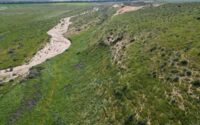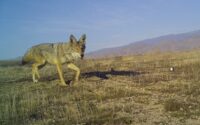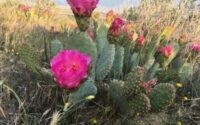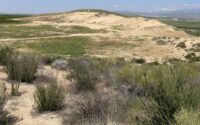

Area: 70 acres
Location: 15 miles southeast of Bakersfield, Kern County, California.
Date Acquired: 2024
Acquisition Type: The Center for Natural Lands Management owns the Caliente Preserve. We protect and manage listed species and their habitat on the Preserve in perpetuity.
Key Habitats: California Annual and Perennial Grassland, Desert Scrub (interior dune scrub), Desert Wash (alluvial scrub)
Species of Special Interest to CNLM: Bakersfield cactus (Opuntia treleasei (=Opuntia basilaris var. treleasei)) and the San Joaquin Valley giant flower-loving fly (Rhaphiomidas trochilus) are known to inhabit the Preserve. The Sand Ridge Jerusalem cricket (Stenopelmatus n. sp.) and the Bakersfield legless lizard (Anniella grinnelli) are also likely to occur on the site. Historic records of the endangered blunt-nosed leopard lizard (Gambelia sila) have been found close to the Preserve.
Introduction
Before acquisition by CNLM, Caliente Sand and Mineral Company (CSMC) owned the Property that is now the Caliente Preserve. A 19-acre portion of the Property was operated by CSMC as a commercial sand mine between 1975 and 2020. Interest in acquiring the Property became more acute after a petition to list the GFLF as endangered in 2014 as permanently protecting this site was thought to be important in preventing the extinction of this endemic species. The Property also contains hundreds of clumps of Bakersfield cactus making it an important site for conserving this endangered species.
After discussions with CSMC about selling the Property, CNLM applied for and received a grant from the US Bureau of Reclamation to purchase the site in 2020. The Property was acquired in June of 2024.
Conservation Significance
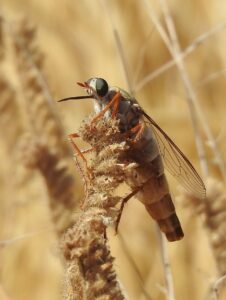 Like CNLM’s Sand Ridge Preserve to the North, the Caliente Preserve encompasses a portion of Sand Ridge and part of the floodplain of Caliente Creek, an intermittent stream with headwaters in the Sierra Nevada and Piute Mountains. The Sand Ridge portion of the Preserve rises approximately 120 feet above the Caliente Creek floodplain and is composed of alluvial and wind-deposited sand. Sand systems are extremely rare within the San Joaquin Valley and they often have relatively unique plant communities as well as rare and endemic species. The Preserve is no exception in that it is known to harbor a robust population of the endangered Bakersfield cactus, and at least one invertebrate species that is only found on Sand Ridge, the San Joaquin Valley flower-loving fly. Another endemic species, the Sand Ridge Jerusalem cricket (Stenopelmatus sp. nov.) likely inhabits the Preserve as well as the Bakersfield legless lizard. In addition, historic records of the endangered blunt-nosed leopard lizard have been found within the Caliente Creek floodplain, near the Preserve.
Like CNLM’s Sand Ridge Preserve to the North, the Caliente Preserve encompasses a portion of Sand Ridge and part of the floodplain of Caliente Creek, an intermittent stream with headwaters in the Sierra Nevada and Piute Mountains. The Sand Ridge portion of the Preserve rises approximately 120 feet above the Caliente Creek floodplain and is composed of alluvial and wind-deposited sand. Sand systems are extremely rare within the San Joaquin Valley and they often have relatively unique plant communities as well as rare and endemic species. The Preserve is no exception in that it is known to harbor a robust population of the endangered Bakersfield cactus, and at least one invertebrate species that is only found on Sand Ridge, the San Joaquin Valley flower-loving fly. Another endemic species, the Sand Ridge Jerusalem cricket (Stenopelmatus sp. nov.) likely inhabits the Preserve as well as the Bakersfield legless lizard. In addition, historic records of the endangered blunt-nosed leopard lizard have been found within the Caliente Creek floodplain, near the Preserve.
The Caliente Preserve is adjacent to CNLM’s Sand Ridge Preserve and CDFW’s Bakersfield Cactus Ecological Reserve and provides an important link between the two conservation areas.
Vegetative Communities
The vegetative communities on the Property consist of annual grassland, interior dune scrub, and alluvial scrub. Annual grassland is the most common community and is found mostly on the western slopes of Sand Ridge and the flat terrain adjacent to Caliente Creek. Dominant plants in this community include ripgut brome (Bromus diandrus), short-pod mustard (Hirschfeldia incana), and Saharan mustard (Brassica tournifortii). Within this community, grasses and other herbaceous species tend to form dense stands, sometimes approaching 100 percent vegetative cover. The interior dune scrub community is found on the ridgetops and eastern slopes which are inhabited by a variety of shrub species including cheesebush (Ambrosia salsola), California ephedra (Ephedra californica), brittlebush (Encelia farinosa), desert croton (Croton californicus), and desert four o’clock (Mirabilus multiflora). This community tends to have less herbaceous vegetation and more open sand than the grassland community. There are a variety of herbaceous species within the interior dune scrub community with some of the more common species being desert dandelion (Malacothrix californica), chia sage (Salvia columbariae), lupines (Lupinus spp.), and sun cups (Camissonia sp.). Alluvial scrub is found within and immediately adjacent to Caliente Creek. This community is dominated by widely scattered California broomsage (Lepidospartum squamatum) shrubs with a similar variety of understory species as interior dune scrub. Approximately 19 acres of the property were disturbed through the sand mining operation, but this area has recently been recontoured and seeded with native vegetation.
Our Work
The overall management objective at the Caliente Preserve is to maintain a functioning ecosystem that supports Bakersfield cactus and other rare species. The primary threats to the ecosystem are a result of ripgut brome (Bromus diandrus), Saharan mustard (Brassica tournefortii), and other nonnative plants that compete with the native species for space, water, and nutrients. Illegal activities such as off-road vehicle use, vandalism and dumping also occur at times.
Public Access
Due to the vulnerability of the species and habitats that exist on this Preserve, it is not open to the public..
For information and inquiries please contact:
Greg Warrick, Preserve Manager at gwarrick@cnlm.org or 760.731.7790 extension 202


